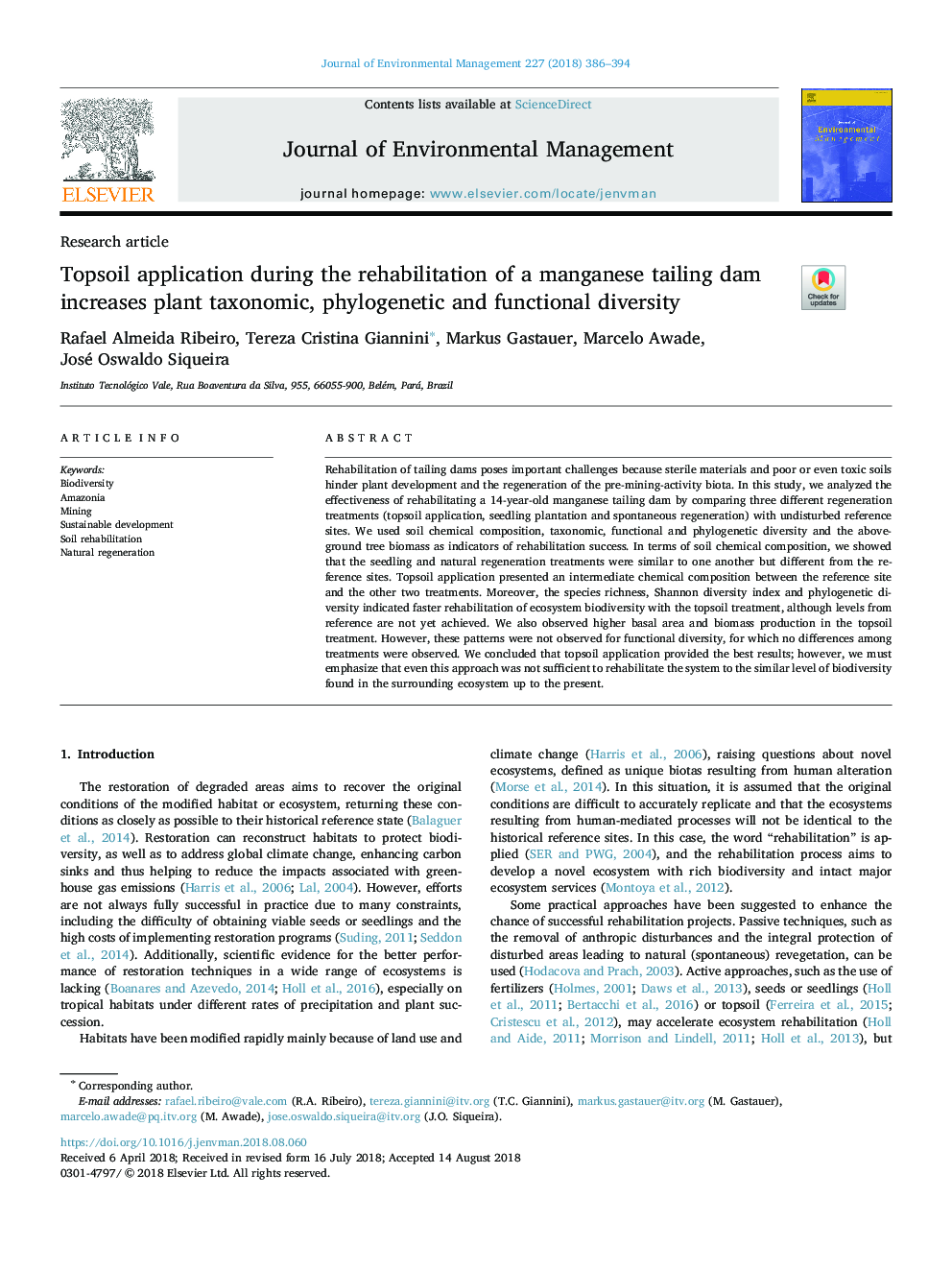| کد مقاله | کد نشریه | سال انتشار | مقاله انگلیسی | نسخه تمام متن |
|---|---|---|---|---|
| 10140650 | 1646036 | 2018 | 9 صفحه PDF | دانلود رایگان |
عنوان انگلیسی مقاله ISI
Topsoil application during the rehabilitation of a manganese tailing dam increases plant taxonomic, phylogenetic and functional diversity
ترجمه فارسی عنوان
کاربرد خاکستر در طی بازسازی یک سد تالس منگنز باعث افزایش گیاه تاکسونومیک، فیلوژنتیک و تنوع عملکردی
دانلود مقاله + سفارش ترجمه
دانلود مقاله ISI انگلیسی
رایگان برای ایرانیان
کلمات کلیدی
تنوع زیستی، آمازونیا، معدن، توسعه پایدار، توانبخشی زمین، بازسازی طبیعی،
ترجمه چکیده
بازسازی سدهای دگرسانی چالش های مهمی را ایجاد می کند زیرا مواد استریل و خاک های ضعیف و یا حتی سمی مانع توسعه گیاهان و احیای زیستگاه پیش از معدن می شود. در این مطالعه، اثربخشی بازسازی یک سد دهانه 14 ساله منگنز را با مقایسه سه روش بازسازی متفاوت (کاربرد نرمی خاک، کاشت نهال و بازسازی خودبهخود) با سایت های مرجع مجدد، مورد بررسی قرار دادیم. ما از ترکیب شیمیایی خاک، تنوع تاکسونومی، فیزیولوژیکی و فیزیولوژیکی و بیوماس درختان زمین به عنوان شاخص های موفقیت توانبخشی استفاده کردیم. از لحاظ ترکیب شیمیایی خاک، ما نشان دادیم که گیاهچه و درمان های طبیعی بازسازی مشابه یکدیگرند اما متفاوت از سایت های مرجع هستند. کاربرد خاکستری ترکیب شیمیایی متوسط بین سایت مرجع و دو روش دیگر را نشان داد. علاوه بر این، غنای گونه، شاخص تنوع شانون و تنوع فیلوژنتیک، بهبود سریع تنوع زیستی اکوسیستم را با استفاده از درمان های سطحی خاک نشان می دهند، اگر چه سطح از مرجع هنوز به دست نیامده است. ما همچنین سطح پایه بالا و تولید زیست توده را در درمان سطح خاک مشاهده کردیم. با این حال، این الگوها برای تنوع عملکردی مشاهده نشد، که در آنها هیچ تفاوتی بین تداخلات مشاهده نشد. ما نتیجه گرفتیم که کاربرد نرم افزاری خاک بهترین نتیجه را ارائه می دهد؛ با این حال، ما باید تأکید کنیم که حتی این روش برای بازگرداندن سیستم به سطح مشابه تنوع زیستی موجود در اکوسیستم اطراف تا کنون کافی نبود.
موضوعات مرتبط
مهندسی و علوم پایه
مهندسی انرژی
انرژی های تجدید پذیر، توسعه پایدار و محیط زیست
چکیده انگلیسی
Rehabilitation of tailing dams poses important challenges because sterile materials and poor or even toxic soils hinder plant development and the regeneration of the pre-mining-activity biota. In this study, we analyzed the effectiveness of rehabilitating a 14-year-old manganese tailing dam by comparing three different regeneration treatments (topsoil application, seedling plantation and spontaneous regeneration) with undisturbed reference sites. We used soil chemical composition, taxonomic, functional and phylogenetic diversity and the above-ground tree biomass as indicators of rehabilitation success. In terms of soil chemical composition, we showed that the seedling and natural regeneration treatments were similar to one another but different from the reference sites. Topsoil application presented an intermediate chemical composition between the reference site and the other two treatments. Moreover, the species richness, Shannon diversity index and phylogenetic diversity indicated faster rehabilitation of ecosystem biodiversity with the topsoil treatment, although levels from reference are not yet achieved. We also observed higher basal area and biomass production in the topsoil treatment. However, these patterns were not observed for functional diversity, for which no differences among treatments were observed. We concluded that topsoil application provided the best results; however, we must emphasize that even this approach was not sufficient to rehabilitate the system to the similar level of biodiversity found in the surrounding ecosystem up to the present.
ناشر
Database: Elsevier - ScienceDirect (ساینس دایرکت)
Journal: Journal of Environmental Management - Volume 227, 1 December 2018, Pages 386-394
Journal: Journal of Environmental Management - Volume 227, 1 December 2018, Pages 386-394
نویسندگان
Rafael Almeida Ribeiro, Tereza Cristina Giannini, Markus Gastauer, Marcelo Awade, José Oswaldo Siqueira,
